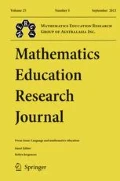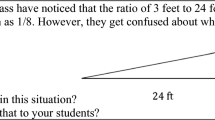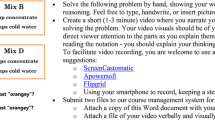Abstract
Proportional reasoning as the capacity to compare situations in relative (multiplicative) rather than absolute (additive) terms is an important outcome of primary school mathematics. Research suggests that students tend to see comparative situations in additive rather than multiplicative terms and this thinking can influence their capacity for proportional reasoning in later years. In this paper, excerpts from a classroom case study of a fourth-grade classroom (students aged 9) are presented as they address an inquiry problem that required proportional reasoning. As the inquiry unfolded, students' additive strategies were progressively seen to shift to proportional thinking to enable them to answer the question that guided their inquiry. In wrestling with the challenges they encountered, their emerging proportional reasoning was supported by the inquiry model used to provide a structure, a classroom culture of inquiry and argumentation, and the proportionality embedded in the problem context.

Similar content being viewed by others
Notes
Both teachers had been part of the inquiry study for 5 years.
Shortly after this unit, the classroom was severely damaged. As a result, some of the research data (including some artefacts, the research notes, and handwritten lesson plans and/or revisions) were destroyed. The details of the research reported in this paper were reconstructed from video, student artefacts and (incomplete) records of lesson plans.
Bratz dolls are similar to Barbie dolls in size but, “are portrayed as teenagers distinguished by large heads and skinny bodies, almond-shaped eyes adorned with eyeshadow, and lush, glossy lips” (Wikipedia)
Students often ignored the 1 in the ratio 1:x and just read the ratio as “x”.
References
Ainley, J., Pratt, D., & Nardi, E. (2001). Normalising: children's activity to construct meanings for trend. Educational Studies in Mathematics, 45(1–3), 131–146.
Ainley, J., Pratt, D., & Hansen, E. (2006). Connecting engagement and focus in pedagogic task design. British Educational Research Journal, 32(1), 23–38.
Allmond, S., & Makar, K. (2010). Developing primary students' ability to pose questions in statistical investigations. In C. Reading (Ed.), Proceedings of the 8th international conference on teaching statistics. Voorburg, The Netherlands: International Statistical Institute.
Allmond, S., Wells, J., & Makar, K. (2010). Thinking through mathematics: engaging students in inquiry-based learning. Melbourne: Curriculum Press.
Andriessen, J. (2006). Arguing to learn. In R. K. Sawyer (Ed.), The Cambridge handbook of the learning sciences (pp. 443–459). New York: Cambridge University Press.
Baber, R. L. (2011). The language of mathematics: utilizing math in practice. New York: Wiley.
Behr, M., Harel, G., Post, T., & Lesh, R. (1992). Rational number, ratio and proportion. In D. Grouws (Ed.), Handbook on research of teaching and learning (pp. 296–333). New York: McMillan.
Berland, L. K., & Reiser, B. J. (2009). Making sense of argumentation and explanation. Science Education, 93(1), 26–55. doi:10.1002/sce.20286.
Blumenfeld, P. C., Kempler, T. M., & Krajcik, J. S. (2006). Motivation and cognitive engagement in learning environments. In K. Sawyer (Ed.), The Cambridge handbook of the learning sciences (pp. 475–488). New York: Cambridge University Press.
Cho, K.-L., & Jonassen, D. H. (2002). The effects of argumentation scaffolds on argumentation and problem solving. Educational Technology Research and Development, 50(3), 5–22.
Clark, F., & Kamii, C. (1996). Identification of multiplicative thinking in children in grades 1–5. Journal for Research in Mathematics Education, 27(1), 41–51.
Cobb, P., & McClain, K. (2006). Guiding inquiry-based math learning. In K. Sawyer (Ed.), The Cambridge handbook of the learning sciences (pp. 171–186). New York: Cambridge University Press.
Cobb, P., Confrey, J., diSessa, A., Lehrer, R., & Schauble, L. (2003). Design experiments in educational research. Educational Researcher, 32(1), 9–13.
Coffield, F. (Ed.). (2000). The necessity of informal learning. Bristol, UK: The Policy Press.
Confrey, J. (1991). Learning to listen: a student's understanding of powers of ten. In E. von Glasersfeld (Ed.), Radical constructivism in mathematics education (pp. 111–138). Dordrecht, The Netherlands: Kluwer.
Confrey, J. (1998). Voice and perspective: hearing epistemological innovation in students' words. In M. Larochelle, N. Bednarz, & J. W. Garrison (Eds.), Constructivism and education (pp. 104–120). New York: Cambridge University Press.
Confrey, J. (2008, July). A synthesis of the research on rational number reasoning: a learning progressions approach to synthesis. Paper presented at the 11th International Congress of Mathematics Instruction, Monterrey Mexico.
Confrey, J. (2010). Response commentary: “Both and”—Equity and mathematics: a response to Martin, Gholson, and Leonard. Journal of Urban Mathematics Education, 3(2), 25–33.
Confrey, J., & Smith, E. (1995). Splitting, covariation, and their role in the development of exponential functions. Journal for Research in Mathematics Education, 26(1), 66–86.
Corbin, J., & Strauss, A. (2008). Basics of qualitative research: techniques and procedures for developing grounded theory. Thousand Oaks, CA: Sage.
Cramer, K., Post, T., & Currier, S. (1993). Learning and teaching ratio and proportion: research implications. In D. T. Owens (Ed.), Research ideas for the classroom: middle grade mathematics (pp. 159–178). New York: Macmillan.
Dewey, J. (1910/1997). How we think. Mineola, NY: Dover Publications.
Dewey, J. (1929/1960). The quest for certainty: a study of the relation of knowledge and action. New York: Capricorn Books.
Diezmann, C., Watters, J., & English, L. (2001). Difficulties confronting young children undertaking investigations. Paper presented at the 26th Annual Meeting of the International Group for the Psychology of Mathematics Education. Utrecht, The Netherlands.
Dole, S., Clarke, D., Wright, T., & Hilton, G. (2012a). Students' proportional reasoning in mathematics and science. In T. Tso (Ed.), Proceedings of the 36th Conference of the International Group for the Psychology of Mathematics Education (Vol. 2, pp. 195–202). Taipei, Taiwan: PME.
Dole, S., Makar, K., & Gillies, R. (2012b). Enacting the intended curriculum through inquiry pedagogy. Paper presented in Topic Study Group 32: Mathematics Curriculum Development. The Twelfth International Congress of Mathematics Education, Seoul Korea
Engle, R. A., Lam, D. P., Meyer, X. S., & Nix, S. E. (2012). How does expansive framing promote transfer? Several proposed explanations and a research agenda for investigating them. Educational Psychologist, 47(3), 215–231.
English, L., & Halford, G. (1995). Mathematics education: models and processes. Mahwah, NJ: Erlbaum.
Erduran, S., & Jiménez-Aleixandre, M. P. (Eds.). (2008). Argumentation in science education: perspectives from classroom-based research. New York: Springer.
Fielding-Wells, J. (2010). Linking problems, conclusions and evidence: primary students' early experiences of planning statistical investigations. In C. Reading (Ed.), Proceedings of the 8th International Conference on Teaching Statistics. Voorburg, The Netherlands: International Statistical Institute.
Fielding-Wells, J. (2013, July). Inquiry-based argumentation in primary mathematics: reflecting on evidence. Paper presented at the 36th Annual Conference of the Mathematics Education Research Group of Australasia. Melbourne, Australia.
Fielding-Wells, J., & Makar, K. (2008, July). Using mathematical inquiry to engage student learning within the overall curriculum. Paper presented in the Symposium: The Role of Mathematics in the Overall Curriculum at the 11th International Congress for Mathematics Education, Monterrey, Mexico.
Fielding-Wells, J., & Makar, K. (2012). Developing primary students' argumentation skills in inquiry-based mathematics classrooms. In: van Aalst, J., Thompson, K., Jacobson, M. J., & Reimann, P. (Eds.) The future of learning: Proceedings of the 10th International Conference of the Learning Sciences (vol 2, pp. 149–153). International Society of the Learning Sciences: Sydney, Australia.
Freudenthal, H. (1981). Major problems of mathematics education. Educational Studies in Mathematics, 12(2), 133–150.
Goos, M. (2002). Understanding metacognitive failure. Journal of Mathematical Behavior, 21(3), 283–302.
Goos, M. (2004). Learning mathematics in a classroom community of inquiry. Journal for Research in Mathematics Education, 35(4), 258–291.
Hancock, C., Kaput, J. J., & Goldsmith, L. T. (1992). Authentic inquiry with data: critical barriers to classroom implementation. Educational Psychologist, 27(3), 337–364.
Harel, G., & Koichu, B. (2010). An operational definition of learning. Journal of Mathematical Behavior, 29(3), 115–124.
Hart, K. (1981). Children's understanding of mathematics 11–16. London: John Murray.
Hattie, J. (2009). Visible learning: a synthesis of over 800 meta-analyses relating to achievement. New York: Routledge.
Hilton, A., Hilton, G., Dole, S., Goos., M., & O’Brien, M. (2012). Evaluating middle years students’ proportional reasoning. In: J. Dindyal, L. Chen, & S. Ng. (Eds.). Mathematics education: expanding horizons. Singapore: MERGA. pp. 330–37
Hollingsworth, H., McCrae, B., & Lokan, J. (2003). Teaching mathematics in Australia: results from the TIMSS 1999 video study. Melbourne: Australian Council for Educational Research.
Jonassen, D. H. (2010). Learning to solve problems: a handbook for designing problem-solving learning environments. New York: Routledge.
Kilpatrick, J., Swafford, J., & Findell, B. (Eds.). (2001). Adding it up: helping children learn mathematics. Washington, D. C.: National Academies Press.
Krajcek, J. S., & Blumenfeld, P. C. (2006). Project-based learning. In K. Sawyer (Ed.), The Cambridge handbook of the learning sciences (pp. 317–334). New York: Cambridge University Press.
Lo, J.-J., & Watanabe, T. (1997). Developing ratio and proportion schemes: a story of a fifth grader. Journal for Research in Mathematics Education, 28(2), 216–236.
Magnusson, S., & Palincsar, A. (2005). Teaching to promote the development of scientific knowledge and reasoning about light at the elementary school level. In M. Donovan & J. Bransford (Eds.), How students learn: history, mathematics, and science in the classroom. Washington DC: National Academies Press.
Makar, K. (2004). Developing statistical inquiry. Doctoral dissertation, College of Education, The University of Texas–Austin.
Makar, K. (2007). Connection levers: supports for building teachers' confidence and commitment to teach mathematics and statistics through inquiry. Mathematics Teacher Education and Development, 8(1), 48–73.
Makar, K. (2012). The pedagogy of mathematical inquiry. In R. Gillies (Ed.), Pedagogy: new developments in the learning sciences (pp. 371–397). Hauppauge, NY: Nova Science.
Makar, K., & Fielding-Wells, J. (2011). Teaching teachers to teach statistical investigations. In C. Batanero, G. Burrill, & C. Reading (Eds.), Teaching statistics in school mathematics: challenges for teaching and teacher education (pp. 347–358). New York: Springer.
Makar, K., Fielding-Wells, J., & Allmond, S. (2011, July). Is this game 1 or game 2? Primary children's reasoning about samples in an inquiry classroom. Paper presented at the Seventh International Forum for Research on Statistical Reasoning, Thinking, & Literacy. Texel, The Netherlands.
Muller Mirza, N., Perret-Clermont, A.-N., Tartas, V., & Iannaccone, A. (2009). Psychosocial processes in argumentation. In N. Muller Mirza & A.-N. Perret-Clermont (Eds.), Argumentation and education: theoretical foundations and practices (pp. 67–90). New York: Springer.
National Council of Teachers of Mathematics (2000). Principles and standards for school mathematics. Reston, VA: Author
National Research Council. (2000). Inquiry and the National Science Education Standards: a guide for teaching and learning. Washington, DC: National Academy Press.
Norton, S. (2005). The construction of proportional reasoning. In H. L. Chick & J. L. Vincent (Eds.), Proceedings of the 29th Conference of the International Group for the Psychology of Mathematics Education (Vol. 4, pp. 17–24). Melbourne: PME.
Osborne, J. (2010). Arguing to learn in science: the role of collaborative, critical discourse. Science, 328, 463–466.
Queensland Studies Authority. (2007). Essential learnings: mathematics. Brisbane: Queensland Studies Authority.
Queensland Studies Authority. (2008). Scope and sequence: mathematics. Brisbane: Author.
Reitman, W. (1965). Cognition and thought: an information-processing approach. New York: Wiley.
Resnick, L. B. (2010). Nested learning systems for the thinking curriculum. Educational Researcher, 39(3), 183–197. doi:10.3102/0013189X10364671.
Richland, L. E., Stigler, J. W., & Holyoak, K. J. (2012). Teaching the conceptual structure of mathematics. Educational Psychologist, 47(3), 189–203. doi:10.1080/00461520.2012.667065.
Ritchhart, R., & Perkins, D. N. (2005). Learning to think: the challenges of teaching thinking. In K. J. Holyoak & R. G. Morrison (Eds.), The Cambridge handbook of thinking and reasoning (pp. 775–802). Cambridge, NY: Cambridge University Press.
Rowland, T., & Zazkis, R. (2013). Contingency in the mathematics classroom: opportunities taken and opportunities missed. Canadian Journal of Science, Mathematics, and Technology Education, 13(2), 137–153. doi:10.1080/14926156.2013.784825.
Scardamalia, M., & Bereiter, C. (2006). Knowledge building: theory, pedagogy, and technology. In K. Sawyer (Ed.), The Cambridge handbook of the learning sciences (pp. 97–115). New York: Cambridge University Press.
Schwartz, D. L., Chase, C. C., & Bransford, J. D. (2012). Resisting overzealous transfer: coordinating previously successful routines with needs for new learning. Educational Psychologist, 47(3), 204–214. doi:10.1080/00461520.2012.696317.
Stacey, K. (1992). Mathematical problem solving in groups: are two heads better than one? Journal of Mathematical Behavior, 11, 261–275.
Stacey, K. (2006). What is mathematical thinking and why is it important. Progress report of the APEC project: collaborative studies on innovations for teaching and learning mathematics in different cultures (II)—Lesson study focusing on mathematical thinking.
Stacey, K., & Vincent, J. (2009). Modes of reasoning in explanations in Australian eighth-grade mathematics textbooks. Educational Studies in Mathematics, 72(3), 271–288.
Staples, M. E., & Truxaw, M. P. (2012). An initial framework for the language of higher-order thinking mathematics practices. Mathematics Education Research Journal, 24(3), 257–281.
Steinthorsdottir, O. B., & Sriraman, B. (2009). Islandic 5th-grade girls' developmental trajectories in proportional reasoning. Mathematics Education Research Journal, 21(1), 6–30.
Streefland, L. (1985). Searching for the roots of ratio: some thoughts on the long term learning process (towards…a theory). Educational Studies in Mathematics, 16, 75–94.
Sullivan, P., Clarke, D., & Clarke, B. (2013). Teaching with tasks for effective mathematics learning. New York: Springer.
Van Dooren, W., De Bock, D., Hessels, A., Janssens, D., & Verschaffel, L. (2005). Not everything is proportional: effects of age and problem type on propensities for overgeneralisation. Cognition and Instruction, 23(1), 57–86.
Van Dooren, W., De Bock, D., & Verschaffel, L. (2010). From addition to multiplication … and back: the development of students' additive and multiplicative reasoning skills. Cognition and Instruction, 28(3), 360–381.
von Aufschnaiter, C., Erduran, S., Osborne, J., & Simon, S. (2008). Arguing to learn and learning to argue: case studies of how students' argumentation relates to their scientific knowledge. Journal of Research in Science Teaching, 45(1), 101–131. doi:10.1002/tea.20213.
Walshaw, M. (2007). Editorial: research as a catalyst for the promotion of equity. Mathematics Education Research Journal, 19(3), 1–2.
Yoon, C., Dreyfus, T., & Thomas, M. O. J. (2010). How high is the tramping track? Mathematising and applying in a calculus model-eliciting activity. Mathematics Education Research Journal, 22(1), 141–157.
Zembal-Saul, C., McNeill, K. L., & Hershberger, K. (2013). What's your evidence? Engaging K-5 students in constructing explanations in science. Boston, MA: Pearson.
Acknowledgments
This research was supported by the Australian Research Council (LP0990184; DP120100690), Education Queensland and The University of Queensland. The first author is in receipt of an Australian Postgraduate Award Scholarship and wishes to acknowledge the financial support of the Commonwealth Government.
Author information
Authors and Affiliations
Corresponding author
Additional information
The authors contributed equally to this paper. The order was determined by random device.
Rights and permissions
About this article
Cite this article
Fielding-Wells, J., Dole, S. & Makar, K. Inquiry pedagogy to promote emerging proportional reasoning in primary students. Math Ed Res J 26, 47–77 (2014). https://doi.org/10.1007/s13394-013-0111-6
Received:
Revised:
Accepted:
Published:
Issue Date:
DOI: https://doi.org/10.1007/s13394-013-0111-6




